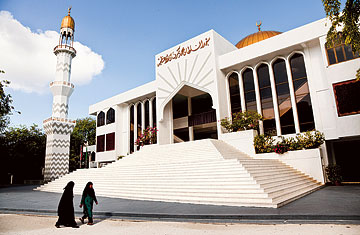
The Grand Mosque in Male
Best Place to Hear the Call to Prayer
Malé
Visitors to the Maldives are often taken aback by Malé, the island nation's capital. Absent here are the country's ubiquitous turquoise lagoons and deserted white-sand beaches, the stuff of dreamy paradise holidays that bring hundreds of thousands of well-heeled tourists to the Indian Ocean archipelago every year. Instead, the city is a maze of concrete, twisting and turning upon an ever-morphing 500-acre (2 sq km) sliver in the sea. The din of industrial saws and hammers rings out during the day; Malé's sole beach is a forlorn artificial one overlooking passing container ships.
But its cramped present belies a very rich heritage. Malé is home to roughly a third of the Maldives' 370,000 people, and a once pivotal waypoint for spice-trading mariners. Maldivians consider themselves the inhabitants of one of the few "100% Muslim" countries in the world, dating back to the 12th century when, according to local lore, a wandering North African mendicant named Abu Barakat arrived and, with prayers, chased away a sea demon that had been preying on the archipelago's virgins. This so awed the Maldivian king and his subjects that they all converted.
Abu Barakat's body is reputedly entombed in a shrine by the Central Mosque in Malé. Some medieval cemeteries with finely etched tombstones abut the city's impressive collection of mosques — there are over two dozen in a space that can be traversed by foot in 25 minutes (among them the Grand Friday Mosque, pictured). Sit out on one of Malé's rooftop cafés at sunset, amid the island's golden domes and modest minarets. As the noise of construction fades, the baleful cries of muezzins, summoning the faithful to prayer, sound across the city. Sometimes in unison, often in competition, the calls achieve a haunting, discordant stillness that few in the capital can ignore. This may not be the paradise advertised in brochures, but the experience is no less sublime.